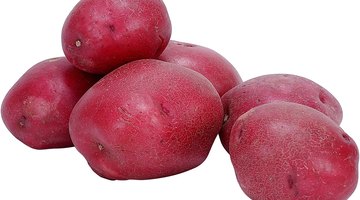How to Make Potato Dextrose Agar
Potato dextrose agar (PDA) is a good general-purpose semisolid medium used for culturing fungi. It is often used to isolate, grow and maintain mushroom-forming species. Ready-made petri dishes or test tubes containing PDA can be purchased, or PDA can be quickly made using a commercial premix.

However, it is not hard to make a simple and effective version from scratch at little cost.
Things You Will Need
- 300 g peeled, chopped potatoes
- Saucepan
- Kitchen strainer or cheesecloth
- pH test paper or pH meter
- 1 molar hydrochloric acid
- 1 molar sodium hydroxide
- 4 500-mL glass Ehrlenmayer flasks (or other narrow-mouthed autoclavable containers)
- 10 g dextrose (glucose) powder
- 20 g agar
- Aluminum foil
- Pressure cooker
- Sterile petri dishes
Tip
Most fungi do well in slightly acidic conditions, so the final pH should be between 6 and 6.5, although it can be adjusted to whatever pH is required for a specific species. Hold petri dish lids open just far enough to allow medium to be poured in and cover as quickly as possible. It takes some practice to gain speed and efficiency in pouring agar into petri dishes. After cooling and solidifying, PDA plates may be wrapped in plastic and stored in a refrigerator for months. Most tap water contains minerals beneficial for fungal growth; however, if local water has extreme mineral concentrations or has a very high or low pH, substitute distilled water.
Warning
Follow all operating and safety instructions for the model of pressure cooker being used. Leave flask lids loose when sterilizing in the pressure cooker to avoid overpressurization. Use heat-resistant gloves when handling hot media containers. Wear safety glasses when operating the pressure cooker, removing sterilized PDA and during pouring.
Preparing Potato Extract
-
Place potatoes in a saucepan with approximately 1.2 liters of tap water and boil on a stove for 1 hour.
-
Remove saucepan from heat and let liquid cool until it can be comfortably handled (about 10 minutes).
-
Pour liquid potato extract through a strainer or cheesecloth and collect it in another container.
Preparing the Medium
-
Add dextrose and agar to 1 liter of the potato extract water.
-
Test the pH of the solution with pH test paper or a pH meter.
-
If the pH is above 6.5, adjust it down by adding one drop of the hydrochloric acid solution at a time and retesting.
-
If the pH is below 6, adjust it up by adding one drop of the sodium hydroxide solution at a time and retesting.
Sterilization
-
Thoroughly mix the medium and divide it into smaller batches of 250 mL poured into the four 500-mL flasks (Note: each flask must be no more than half full to avoid boil over).
-
Cover each flask with a piece of loosely crimped aluminum foil, so the foil will not fall off, but does not make a tight seal.
-
Place the flasks in a pressure cooker.
-
Operate the pressure cooker in accordance with the manufacturer's instructions to sterilize the PDA at 121 degrees C (250 degrees F) at a pressure of 103,421 Pascals(15 PSI) for 15 minutes.
-
Shut off the pressure cooker and let it return to atmospheric pressure, then remove the flasks and let them cool until they can be handled.
Pouring the Medium
-
Line up the sterile petri dishes on a flat surface.
-
Once the flasks have cooled to handling temperature, but before the medium begins to solidify, grasp a flask with one hand and remove and set aside its foil lid with the other hand.
-
For each petri dish, lift the lid with one hand, quickly fill halfway with liquid PDA, and replace the lid.
-
Repeat Step 3 above until all petri dished are filled.
-
If there is any PDA left over, loosely recover the flask with its original foil lid, let it cool and solidify, tighten the foil lid and store in a refrigerator.
The Drip Cap
- Potato dextrose agar (PDA) is a good general-purpose semisolid medium used for culturing fungi.
- It is often used to isolate, grow and maintain mushroom-forming species.
- Pour liquid potato extract through a strainer or cheesecloth and collect it in another container.
- If the pH is above 6.5, adjust it down by adding one drop of the hydrochloric acid solution at a time and retesting.
- Once the flasks have cooled to handling temperature, but before the medium begins to solidify, grasp a flask with one hand and remove and set aside its foil lid with the other hand.
References
Resources
Writer Bio
Philip McIntosh has more than 30 years of experience as an equipment engineer, scientific investigator and educator. He has been writing for 16 years, and his work has appeared in scientific journals, popular science magazines, trade journals and on science and technology websites. McIntosh holds a B.S. in botany and chemistry, and an M.A. in biological science.
Photo Credits
- Zedcor Wholly Owned/PhotoObjects.net/Getty Images
- Zedcor Wholly Owned/PhotoObjects.net/Getty Images
More Articles



